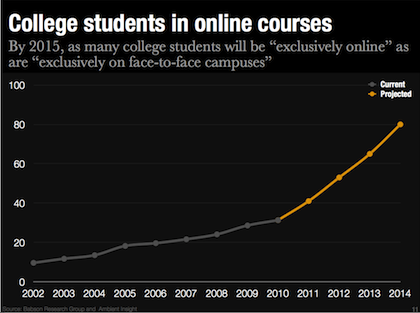In my last post in the series on educational technology, I described the concept of disruptive innovation – or the impact that technology can have on an industry or specific business.
To illustrate this, I want to explore three ways in which technology is disrupting education, which I will describe as:
- The Death of Distance,
- The Long Tail,
- and the opening of New Markets.
The phrase “The Death of Distance” was first coined in 1995 to describe the impact technology would have on communication. It has since expanded to explain the impact that other technologies are having on sales, marketing, and manufacturing.
To better understand the concept, think about the impact that Amazon has had on retail shopping or the impact that foreign call centers have had on the “help desk” industry. A recent series in the New York Times used Apple to illustrate the how much manufacturing has gone global. While Apple employs 43,000 people in the US and 20,000 people overseas, nearly 700,000 people work for contractors that make the iPhone and iPad – mostly overseas.
The article included a now famous snippet of a conversation between Steve Jobs and President Obama, in which the President asked Jobs what it would take to make the iPhone or iPad in the US. “These jobs are not coming back,” Jobs told him flatly.
In education, the explosion of online learning can be use to illustrate the Death of Distance in action.
Studies from the Babson Research Group and Ambient Insight, graphed below, indicate the adoption of online learning will only grow. By 2014, 80% of college students are projected to take at least one course online. Research also predicts that by 2015, there will be the same number of college students in “exclusively online” schools as those in “exclusively face-to-face” schools.
The death of distance for education means that students no longer need to be in the same physical space as their instructors. While independent study and correspondence courses have been around forever, new methods for instruction online are making courses more available, more interactive, and thus more attractive for a much larger population.
In the same way that industry has been irrevocably changed by globalization of the manufacturing process, online learning has moved well beyond the “fad” that it was once called.
In my next posts we’ll look at how the Long Tail and opening of New Markets are powering this disruptive trend.
